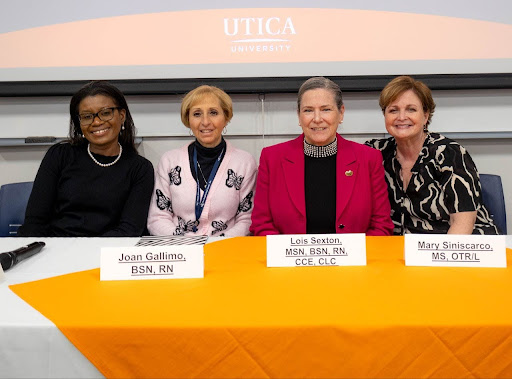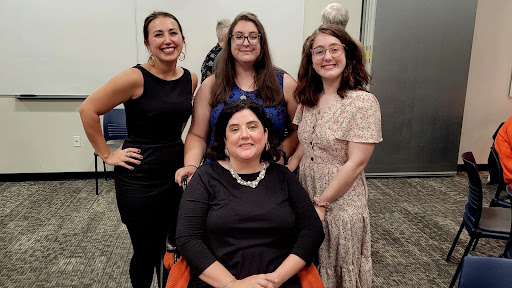President Laura Casamento held a Town Hall meeting on April 21 for faculty and staff addressing the financial state of Utica College. The meeting covered many pivotal topics from this academic year, including the impacts of the coronavirus, the enrollment and retention rates and the College’s strategic plan in the next five years.
The Continuing Dilemma of Enrollment and Retention Rates
Utica College’s primary focus, at least for the latter half of the recent decade, has been to increase its retention and enrollment rates. Many databases indicate that the College’s retention rate, at least for the times before the pandemic, hovered between 70% and 73%. At the meeting, it was revealed that the College saw a 14% decrease in overall enrollment in the past four years.
Kelly Adams, the assistant vice president for marketing and communications, indicated that this number directly correlates to a declining number of high school graduates, particularly in the Northeast portion of the country. This is confirmed, as of 2018, by The National Center for Education Statistics which published a study in December of that year indicating a sharp increase in high school dropout rates, specifically in low-income populations.
“In the fall of 2016, we brought in a freshman class of 685 and had to rent an entire wing of an off-campus hotel to accommodate residential student capacity,” Adams said. “Long term, this was not a sustainable strategy, and it led to lower retention. Today, we are targeting a freshman class of 550. So clearly part of the decline is attributable to strategy.”
Another factor to consider for this time period, however, is the tuition reset of that academic year. The impacts of the decision, both financially and in terms of overall enrollment, continue to impact the College to this day.

Competition also arises from New York State with the Excelsior Scholarship. The financial impacts of the scholarship can give qualifying students money covering some of their respective fees to pay for a state school. It also impacts Utica College, which does not qualify for the scholarship, as prospective students may seek out a cheaper alternative to higher education in the future.
However, Casamento believes that current Utica College fees for tuition and room and board will remain competitive with the benefits of the Excelsior Scholarship moving forward. Right now, the College charges students just above $10,000 per semester in tuition fees, with room and board fees in variance depending on where students live on campus.
The bright side to this topic is that UC is seeing an increase in first-year applications for the fall semester. This news comes after it announced a full return to in-person operations next semester. Casamento has encouraged faculty to prompt their students to return in person for the fall and has every bit of confidence that the students will follow suit.
“I encourage as many students as possible to get their COVID vaccine,” she said. “Students may not know this, but anyone who has been fully vaccinated does not have to quarantine after exposure to someone who has the virus. This is great news and goes a long way towards bringing back a sense of normalcy to day-to-day living on campus. So my message to students is: please get vaccinated.”
Financial impacts
As expected, the coronavirus impacted Utica College in a number of ways, especially in terms of the school’s financial position. For the 2021 fiscal year, the institution is expecting to exceed costs of $3 million.
The College also released its overall operating budget expenses and revenues for the academic year. Expenses this year dropped from $80.3 million in 2020 to $77.4 million, but are predicted to jump up again to $82.8 million next year. It’s estimated that the College’s expenses broke down for this fiscal year in these categories:
- Salaries and Benefits – $48.5 million
- Operating Expenses – $22.7 million
- Auxiliary Expenses – $3.7 million
- Debt Services – $2.5 million
The College’s operating budget cash surplus is estimated at $2.2 million, while its DOE for this year was 2.4%. Generally, any percentage above 2% signifies that a higher education institution has enough of a cash cushion to cover things out of its control.
Recent Posts
- ‘Just come try it’: Women’s Wrestling Team looking for new members
- Slashed SGA budget sparks student frustration at recent meeting
- Editorial: Your campus, your voice – How to reach us when you want to speak out and how we make editorial decisions
- Op-Ed: Why Black student perspectives matter in campus reporting
- Conservative activist Charlie Kirk’s death shocks Utica University students
In terms of revenues, Utica College made most of its money from undergraduate fees totaling $39.6 million with graduate student fees falling behind with $16.9 million. The school collected an extra $4.3 million in fees and $10.3 million in auxiliary revenues, with another $8.7 million labeled as “other.”
Elements helping the College’s financials include endowments, gifts and The Higher Education Relief Fund (HEERF). As of March 31, the College has received $33.5 million in endowments or money that is donated to an organization for a specific purpose. A hefty portion of this money has been used on UC’s new infrastructure, both on and off-campus, which has increased in the last five years. According to Casamento, the College received $3.5 million in gifts directed to the endowment in the past 18 months.
HEERF is an element within the Coronavirus Aid, Relief, and Economic Security Act (CARES Act), passed by Congress on March 27, 2020. The fund is split into three different parts, all received at different times. The first two rounds of funding totaled $6.5 million.
In the first round, $1.2 million was sent directly to the students in the form of emergency grant financial aid. The remaining half was spent covering the College’s losses of $2.3 million from room and board revenue as a result of the closing of the school during the outbreak of the coronavirus last March.
Another $4.1 million was granted in the second round. Similar to the first round of funding, the College allocated a portion of the money toward student emergency aid, but the remaining money was used to cover COVID-19 expenses. According to Casamento, PCR-saliva testing was by far the biggest coronavirus-related expense, although an exact number of how much it cost wasn’t provided.
UC is waiting for the third fund to hit, totaling $7.2 million.
“$3.6 million of which will be used for emergency grant aid and sent directly to students based on updated conditions and requirements,” Casamento said. “The remaining $3.6 million will be used for any further COVID-19 mitigation expenses and to partially offset the loss of tuition, room, board and other revenue directly related to COVID-19.”

Utica College’s Focus for the Future
The College has rapidly expanded its presence, specifically with infrastructure, in recent years. Expect more of that, but in a different style in the next five years. The plan is to diversify revenue by modality and geography.
Utica College will further develop its High School Bridge Program, giving students the opportunity through certain coursework to complete a full year of college – in terms of credits – before attending. There will also be a focus on expanding and developing all levels of study, from bachelor’s to doctorate programs, along with a huge change in the College’s core course requirements.
Geographically, Utica College plans to put some focus on the Florida campus as well. Later this year or in early 2022, the College will expand to create a third academic site in the state. According to Casamento, the site will likely be located in Pasco County, which is located on the Western side of the state, just north of Tampa.
All of these plans fall in accordance with Utica College’s strategic plan from 2020 until 2025.
“Some of the tactics detailed in the Strategic Plan include the following: Create general education pathways that honor broad interdisciplinary perspectives, transferable skills, and integration of majors; Create academic offerings to attract and retain underserved student populations; Implement a coherent model of experiential learning opportunities that integrate major-related experiences for first-year students,” Casamento said.
The topics tie together within the College’s plans of trying to remain fiscally prudent in the future. Keeping spending numbers in line with the College’s sources of revenue will allow the school to fund these initiatives without gathering any debt.
“We need to invest our resources in initiatives and programs that have both a measurable and meaningful return on investment,” Casamento said.













































































































































